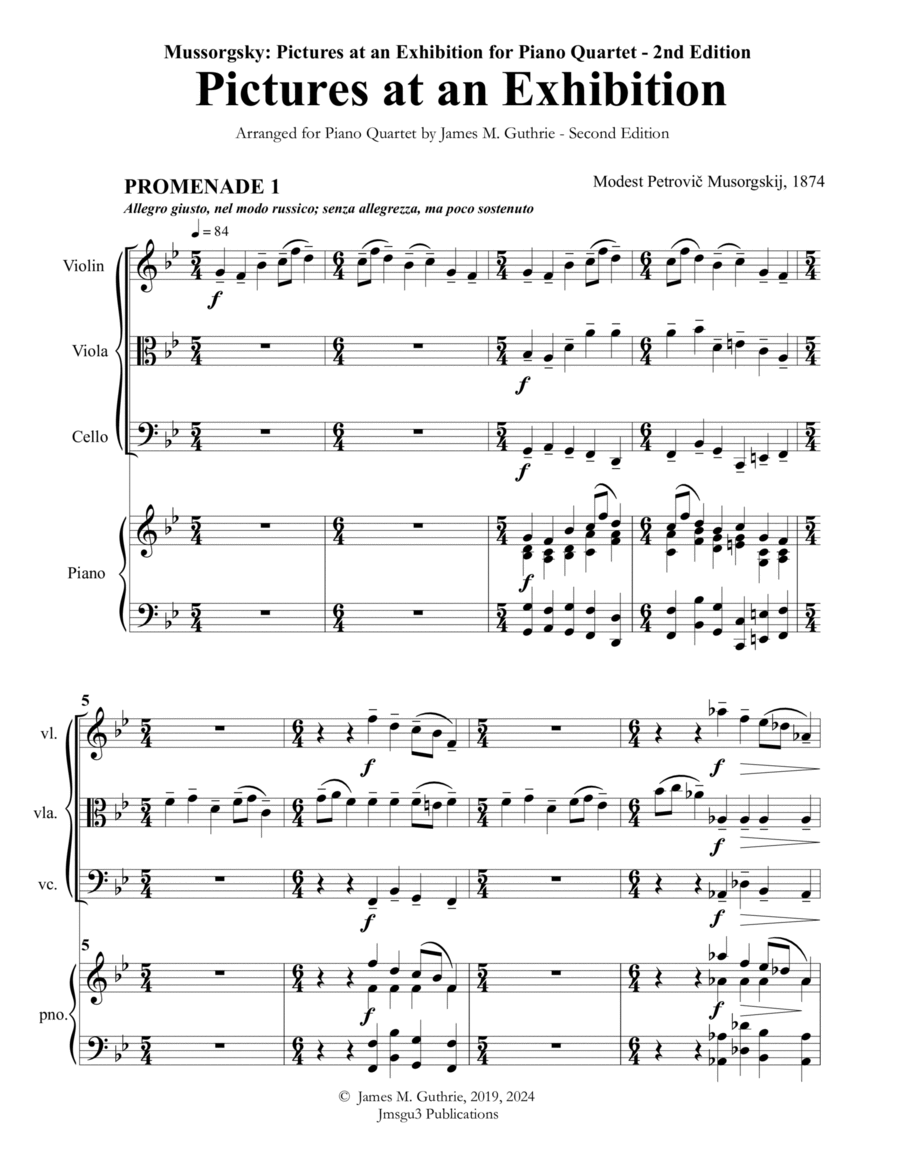Piano Quartet Cello,Piano,Viola,Violin - Level 5 - Digital Download SKU: A0.1398434 Composed by Modest Petrovich Mussorgsky. Arranged by James M. Guthrie. 19th Century,Chamber,Contest,Festival,Historic,Romantic Period. 219 pages. Jmsgu3 #981709. Published by jmsgu3 (A0.1398434). The Second edition features more textural variety and interplay between the strings and piano.Mussorgsky is known for his ability to evoke vivid pictures through his music. He creates soundscapes that transport listeners to other places and times. Using complex harmonies and shifting tonalities, Mussorgsky creates sonic paintings that are as diverse and varied as any works of art in a museum. He takes listeners on a journey through different landscapes and environments, ranging from pastoral settings to the underworld depths. In his famous suite, Pictures at an Exhibition, Mussorgsky gives each movement a title referencing a painting, sculpture, or architectural feature from an art museum. The suite is composed to capture the moods and emotions the artworks evoke. From the bright and energetic Promenade to the somber and mysterious Catacombs, Mussorgsky's Pictures at an Exhibition paints a vivid sonic landscape that brings the listener into the art museum.Pictures at an Exhibition (ŠŠ°ŃŃŠøŠ½ŠŗŠø Ń Š²ŃŃŃŠ°Š²ŠŗŠø) by Modest PetroviÄ Musorgskij, 1874(ŠŠ¾Š“ŠµŃŃ ŠŠµŃŃŠ¾Š²ŠøŃ ŠŃŃŠ¾ŃŠ³ŃŠŗŠøŠ¹) Arranged for Piano Quartet by James M. Guthrie (ŠŠ¶ŠµŠ¹Š¼Ń Š. ŠŠ°ŃŃŠø)Score: 103 pages, 924 measures, duration: 34:30.Ā Contents:Ā Promenade 1 Allegro giusto, nel modo russico; senza allegrezza, ma poco sostenutoĀ 1. GNOMUS (The Gnome) Sempre vivoĀ Ā Promenade 2 Moderato commodo assai e con delicatezzaĀ Ā 2. IL VECCHIO CASTELLO (The Old Castle) Andante molto cantabile e con doloreĀ Ā Promenade 3 Moderato non tanto, pesamenteĀ Ā 3. TUILLERIES Dispute d'enfants aprĆØs jeux (Children's Quarrel after Games)Ā Ā Ā Allegretto non troppo, capricciosoĀ 4. BYDLO (Cattle) Sempre moderato pesanteĀ Promenade 4 TranquilloĀ 5. Ballet of the Unhatched Chicks ŠŠ°Š»ŠµŃ Š½ŠµŠ²ŃŠ»ŃŠæŠøŠ²ŃŠøŃ
ŃŃ ŠæŃŠµŠ½ŃŠ¾Š² Ā ScherzinoĀ 6. Samuel Goldenberg und SchmuĆæle Ā ŠŠ²ŃŠµŠ¹ Š² Š¼ŠµŃ
Š¾Š²Š¾Š¹ ŃŠ°ŠæŠŗŠµ. CŠ°Š½Š“Š¾Š¼ŠøŃ AndanteĀ Promenade 5 Allegro giusto, nel modo russico, poco sostenutoĀ 7. LIMOGES. LE MARCHĆ. (La grande nouvelle) The Market (The Great News)Ā Ā Ā Allegretto vivo, sempre scherzandoĀ 8. CATACOMBAE (Sepulchrum romanum) (Roman Tomb) ŠŠ°ŃŠøŠ¶ŃŠŗŠøŠµ ŠŗŠ°ŃŠ°ŠŗŠ¾Š¼Š±Ń LargoĀ Ā Ā Ā CON MORTUIS IN LINGUA MORTUA (With the Dead in a Dead Language)Ā Ā Ā Andante non troppo, con lamentoĀ 9. The Hut on Hen's Legs (Baba Yaga) ŠŠ·Š±ŃŃŠŗŠ° ŠŠ°Š±Ń-ŠÆŠ³Šø Š½Š° ŠŗŃŃŃŠøŃ
Š¾Š¶ŠŗŠ°Ń
. Š§Š°ŃŃ Š² ŃŃŃŃŠŗŠ¾Š¼ ŃŃŠøŠ»ŠµĀ Ā Ā Allegro con brio, feroceĀ Ā 10. The Bogatyr Gates (In the Capital in Kiev) ŠŃŠ¾ŠµŠŗŃ Š³Š¾ŃŠ¾Š“ŃŠŗŠøŃ
Š²Š¾ŃŠ¾Ń Š² ŠŠøŠµŠ²Šµ. ŠŠ»Š°Š²Š½ŃŠ¹ ŃŠ°ŃŠ°Š“The Great Gates of Kiev Allegro alla breve Maestoso con grandezza.
